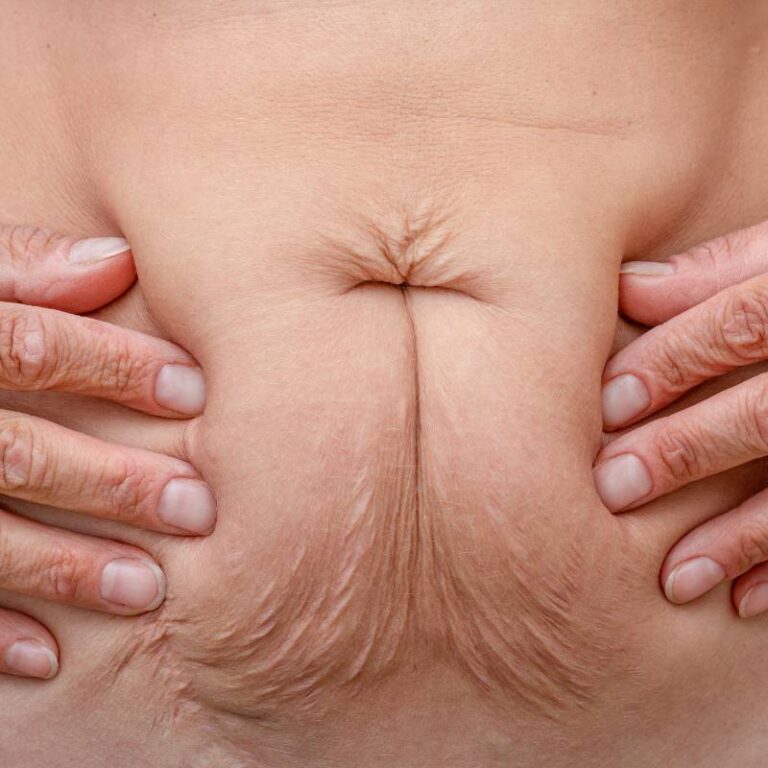Sagging skin after weight loss is a common concern for many who have experienced significant weight loss. When your skin is stretched over a larger body mass for an extended period, it can lose its firmness and elasticity, making it difficult to return to its original shape after losing weight. Whether your weight loss was achieved through diet, exercise, or bariatric surgery, dealing with sagging skin can be frustrating. Thankfully, there are various treatments available to help tighten loose skin and improve its appearance.
Why Does Skin Sag After Weight Loss?
The skin is incredibly elastic, but it has its limits. When you gain weight, your skin stretches to accommodate the extra mass. If this occurs over a long period, the skin’s elasticity can be compromised, making it difficult for the skin to bounce back after the weight is lost. The amount of weight lost, how quickly it was lost, and the length of time the skin was stretched all play significant roles in determining whether your skin will sag post-weight loss. As your body shrinks, the once-stretched skin may not have the ability to tighten back up on its own, leading to loose skin in areas like the arms, stomach, thighs, and buttocks.
Factors That Contribute to Sagging Skin:
- Age: As we age, our skin naturally loses collagen and elastin, making it less resilient.
- Genetics: Your genetic makeup plays a role in your skin’s ability to rebound after weight loss.
- Duration of Obesity: The longer your skin was stretched, the more difficult it may be for it to return to its original shape.
- Rate of Weight Loss: Rapid weight loss can prevent the skin from adjusting properly, leading to sagging.
Non-Surgical Treatments for Sagging Skin
If you’re looking to treat sagging skin without undergoing surgery, there are a variety of non-surgical options available that can help tighten and rejuvenate your skin. These treatments focus on improving skin elasticity, texture, and firmness through advanced skincare and technology.

The Benefits of Skin-Firming Creams and Lotions
Topical treatments such as skin-firming creams and lotions are among the most accessible ways to address sagging skin. These products often contain ingredients like retinoids, hyaluronic acid, and collagen-boosting peptides that work to hydrate the skin and improve elasticity. While these creams won’t remove excess skin, they can help tighten loose skin to some extent, making them a valuable part of your post-weight loss skincare routine.
How Retinoids Can Help Improve Skin Elasticity
Retinoids, derived from vitamin A, are commonly used in skincare products for their ability to boost collagen production. Collagen is a protein that helps maintain the skin’s structure and elasticity. By incorporating retinoids into your skincare routine, you can encourage the production of new collagen, which can improve skin elasticity and help tighten the skin after significant weight loss.
Laser Therapy for Sagging Skin: Is It Effective?
Laser therapy is a non-invasive treatment that uses focused light to stimulate collagen production and improve skin texture. By promoting the regeneration of skin cells, laser treatments can help reduce the appearance of sagging skin and give you smoother, firmer skin. This is particularly beneficial for those who have lost a lot of weight and are looking for non-surgical options to tighten their skin.
Radiofrequency Therapy: A Non-Invasive Option
Radiofrequency energy is another non-invasive treatment option that uses heat to stimulate collagen production and tighten loose skin. This treatment penetrates deep into the skin’s layers, promoting collagen production and providing gradual, natural-looking improvements. Radiofrequency therapy is effective for improving skin elasticity and reducing the appearance of sagging skin after weight loss.
Microneedling for Sagging Skin
Microneedling is a minimally invasive treatment that involves creating tiny punctures in the skin using fine needles. These micro-injuries stimulate the body’s natural healing response, which includes the production of collagen and elastin. By promoting collagen production, microneedling can help improve skin firmness and elasticity, making it an effective option for those dealing with sagging skin after weight loss.
Body Contouring Treatments for Sagging Skin
For those looking for non-surgical body contouring treatments, these treatments can help tighten and tone the skin, giving you a smoother, more contoured appearance. Non-surgical body contouring treatments can be particularly effective for those who have lost significant amounts of weight and are looking to refine their body shape without undergoing invasive treatment.

Natural and Lifestyle-Based Approaches
Lifestyle-based approaches can play a crucial role in improving skin elasticity and reducing sagging skin after weight loss. By adopting healthy habits such as proper hydration, a balanced diet, and regular strength training, you can support your skin’s natural ability to tighten and heal.
The Importance of Hydration for Skin Health
Hydration plays a crucial role in maintaining skin elasticity. Drinking enough water each day helps keep your skin hydrated and supple, making it more resilient to changes in body composition. By staying hydrated, you can support your skin’s ability to tighten and heal after losing weight.
How a Protein-Rich Diet Can Help with Skin Elasticity
Protein is essential for collagen production, which is vital for skin elasticity. Incorporating protein-rich foods into your diet, such as lean meats, fish, eggs, and legumes, can help support your skin’s structure and repair process. A protein-rich diet is especially important for those looking to tighten loose skin after weight loss, as it provides the necessary building blocks for collagen synthesis.
The Role of Antioxidants in Skin Repair
Antioxidants, found in fruits, vegetables, and supplements, help protect the skin from free radical damage and support the body’s natural repair processes. Vitamins C and E are particularly beneficial for skin health, as they promote collagen production and improve skin elasticity. Including antioxidant-rich foods in your diet can help improve skin after weight loss and reduce the appearance of sagging skin.
Strength Training Exercises to Improve Skin Tone
Strength training is an excellent way to build muscle and improve skin tone after significant weight loss. By building muscle mass, you can fill in some of the areas where your skin may appear loose, giving your body a firmer, more toned appearance. Incorporating strength training exercises into your fitness routine can help tighten loose skin and improve your overall physique.

Why Consistent Skincare Routines Matter Post-Weight Loss
Maintaining a consistent skincare routine is essential for supporting healthy skin after weight loss. Regular exfoliation, moisturizing, and the use of targeted treatments like retinoids can help improve skin texture and elasticity. Consistent skincare can also help address areas of sagging skin and promote a smoother, more youthful appearance.
Surgical Options for Treating Sagging Skin
For those with significant amounts of loose skin after weight loss, surgical options may be necessary to achieve the desired results. Body contouring surgery, such as a tummy tuck, arm lift, or thigh lift, can remove excess skin and provide a more sculpted, toned appearance. These procedures are often recommended for individuals who have lost a lot of weight and are looking for a more permanent solution to sagging skin. While these surgeries are invasive treatments, they can provide dramatic results and significantly improve skin appearance.
How Semaglutide Affects Weight Loss and Skin Elasticity
Semaglutide is a medication that can aid in weight loss by helping to regulate appetite and reduce caloric intake. Trouvaille Med Spa offers a semaglutide program that is supervised by our physician, ensuring a safe and effective approach to losing weight. However, like other forms of significant weight loss, semaglutide may lead to sagging skin due to the rapid reduction in body mass. Managing this side effect requires a proactive approach, focusing on treatments and skincare routines that support skin elasticity. A high protein diet is especially important when using any weight loss medication.
Achieving significant weight loss, whether through lifestyle changes or weight loss medications like semaglutide, is a major accomplishment. However, managing the effects of sagging skin afterward requires a comprehensive approach that includes non-surgical treatments, natural lifestyle changes, and, in some cases, surgical options. By taking proactive steps to care for your skin, you can enhance your overall results and feel confident in your transformation.
FAQs about Weight Loss and Sagging Skin
While significant weight loss is more likely to result in sagging skin, even losing a moderate amount of weight, especially rapidly, can sometimes cause the skin to lose some of its elasticity and create a slightly loose appearance.
Yes, areas like the abdomen, arms, thighs, and neck are particularly prone to sagging skin after weight loss due to the amount of fat stored there and the way skin stretches over these areas.
While semaglutide is effective in promoting weight loss, rapid weight reduction can lead to sagging skin as the body sheds fat faster than the skin can adjust. Incorporating skincare and non-surgical treatments can help manage these effects during treatment.
Yes, age is a significant factor. As we age, our skin loses collagen and elastin, making it harder for the skin to bounce back after weight loss. Older adults are more likely to experience sagging skin compared to younger individuals.
Yes, building muscle through strength training can help fill in areas of loose skin and improve overall skin tone, making the skin appear tighter and more toned.




